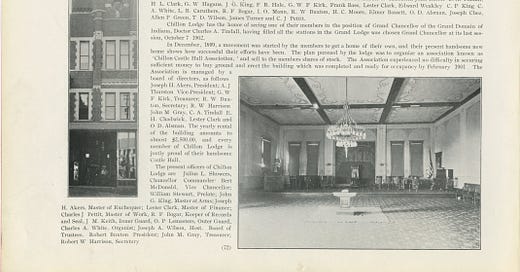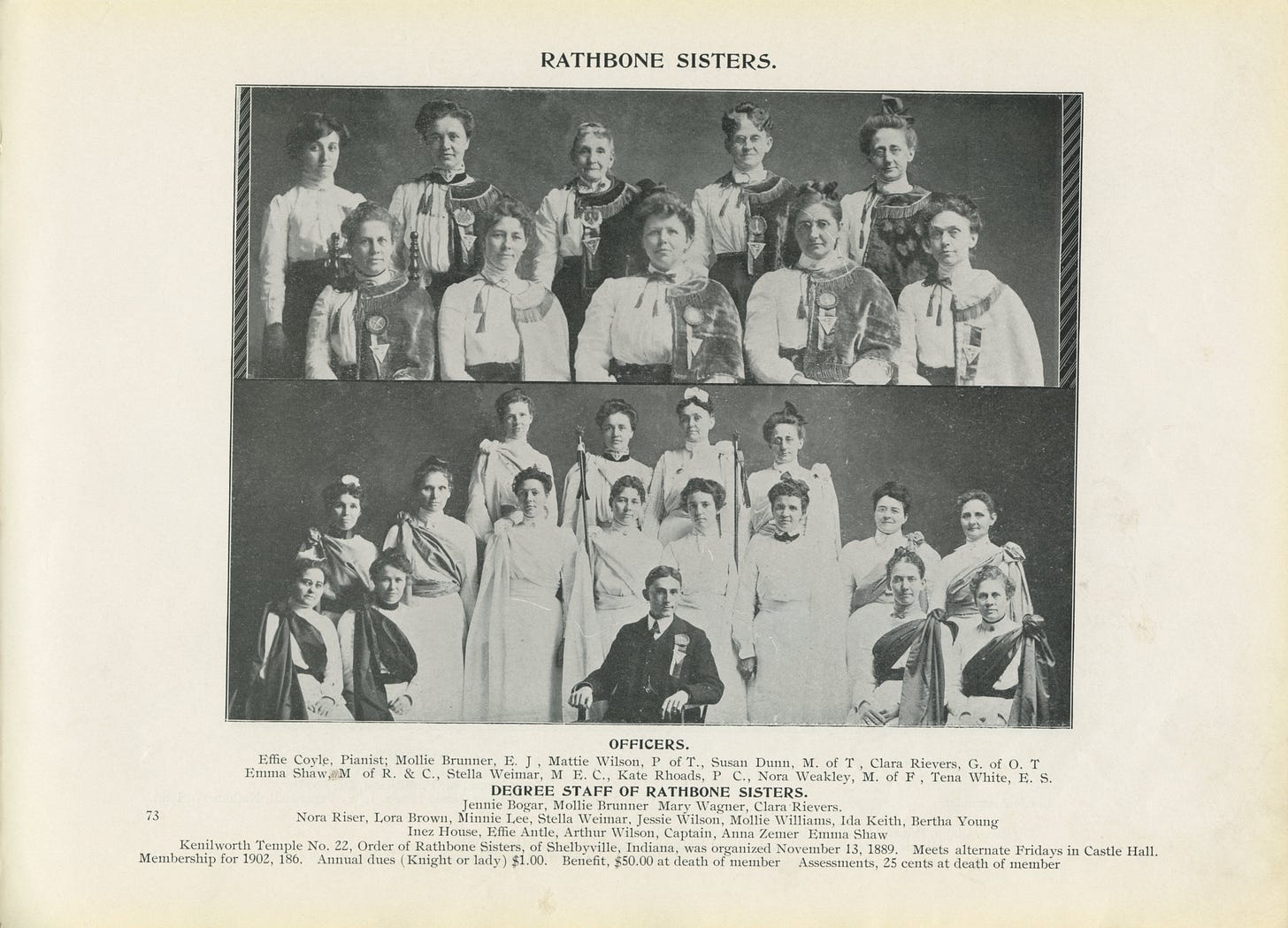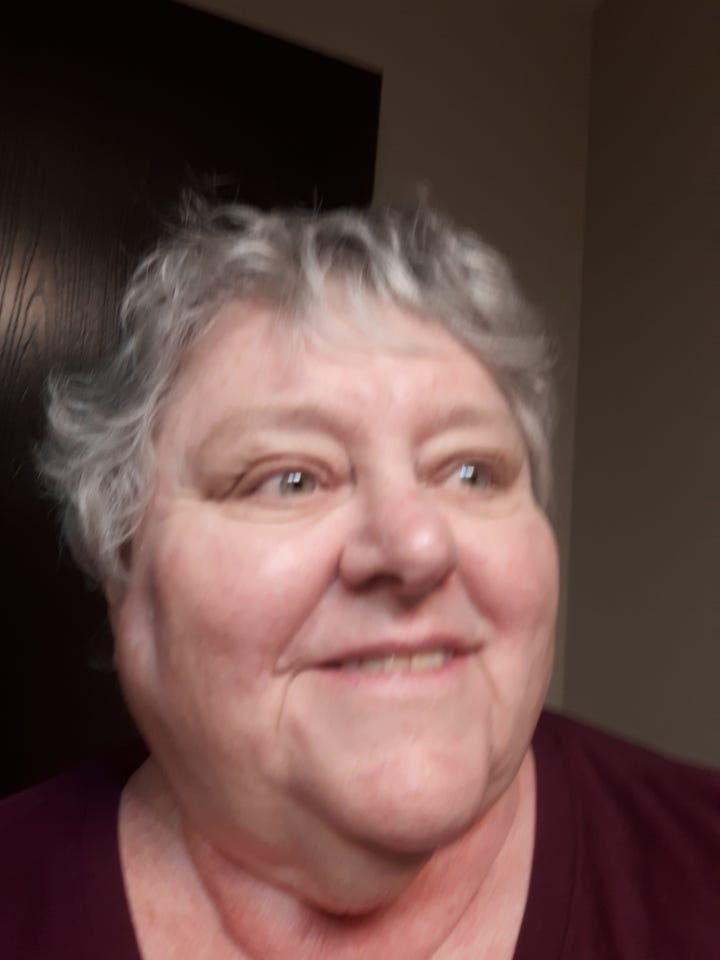NOTEBOOK:
Shelbyville High School’s No. 1 doubles team, comprised of Aiden Smith, a junior, and Wyatt Armstrong, a sophomore, defeated a Union City doubles team, 6-1, 6-2, last night to advance to the individual sectional championship today, 5 p.m. against Perry Meridian at Center Grove.
The Shelbyville Fire Department is holding an open house tomorrow, Saturday, Oct. 12, 10 a.m. to 2 p.m. at 40 W. Broadway St. “Touch-a-Truck,” demonstrations, refreshments and goodie bags will be available.
Do you dig trying to crack cold cases? Is solving crime your M.O.? Test your sleuthing abilities by taking part in “Cold Case: 1883” at Shelby County Public Library on Saturday, October 19 from 1 - 4 pm. Throughout the afternoon, armchair detectives will attempt to solve a real historical Shelby County murder mystery using provided clues and abundant resources found in the Genealogy & History Department at Carnegie East Wing, 33 W. Broadway St. We can’t wait to observe your snooping skills in action! Look forward to one genealogy program and one history program each month. The “Cold Case: 1883” program is free and open to the public. For further information, contact Donna Dennison at (317) 398-8144, ext. 302.
The City of Shelbyville will reveal its new branding at a public session, Tuesday, Oct. 15. “The celebratory event will include a presentation about the research and community input that ultimately helped shape Shelbyville’s new identity and reflects the vibrant spirit and future direction of the city,” a media release said. The event will be held at the Intelliplex Conference Center, 2154 Intelliplex Dr. The new branding process included input from more than 1,000 citizens via surveys and focus groups, the release said.
Also next Tuesday, Oct. 15, a Candidate Forum hosted by the Northwest Shelby County Concerned Citizens Coalition will be held at the Moral Township Fire Department, 7 p.m. Candidates for County Commissioner and County Council will answer questions posed by the members of the group in advance. After the formal Q&A, attendees will be invited to meet the candidates in person as time allows. Contact Donna Dugan, 317-213-6804, donna.dugan@outlook.com, for more information.
NATIONAL NEWS: Usually when one takes out a loan, the lender is interested in previous earnings and income. Not so in the high-flying world of athlete finance; lots of players on the 22 MLB teams that didn’t make the playoffs are done for the season, which means they don’t get paychecks for six months and will need to find a way to keep a roof over their heads through April. That’s where a lender like Sure Sports comes in, which in the last year has provided around $125 million to athletes in offseason loans against not their previous earnings but their future contracts. Loans are capped at 30 percent of a player’s guaranteed deal and interest rates tend to hover between 6.5 percent and 7 percent. For players without a guaranteed deal — usually pre-draft candidates — the math gets a little more elaborate, but at the end of the day it’s an increasingly normal trend in sports. (Sportico/Numlock)
The Addison Times publishes essential news and historical content to build our Shelby County community, and is free thanks to the generosity of supporters. Those who donate a minimum of $5 a month (or $30 one-time) receive the two remaining quarterly Addison Times magazines for 2024 as an appreciation gift. Support The Addison Times here!
Want the daily edition read to you? Struggling with your email provider filtering out your local news? The Addison Times Substack app will solve those challenges!
Young: A Look at National and Local History of Fraternal Organizations
by GEORGE YOUNG
After delving into the history of the Tindall/VanPelt/Court of Honor story, I found myself drawn into a deeper curiosity about the fraternal organizations that thrived during that era.
Like many towns then, Shelbyville was a hub for these influential groups - home to lodges such as the Modern Woodmen of America, Knights of Pythias, Elks, Odd Fellows, and the Grand Army of the Republic. Far more than mere social clubs, these organizations served as crucial support systems, offering camaraderie, financial aid, and a sense of belonging to their members in a rapidly changing world.
Published in 1902, Picturesque Shelbyville was a comprehensive representation of Shelbyville, Indiana's Official, Business, and Social Relations. Mr. Charles H. Tindall, a major force behind this souvenir publication, made sure to include many Secret, Fraternal, and Beneficiary societies. One of the most extensive sections of this book showcased over 20 such groups, a testament to Tindall’s dedication to preserving the history of these organizations.
The Golden Age of Fraternalism refers to a period when membership in fraternal societies in the United States grew rapidly in the latter third of the 19th century and continued into the first part of the twentieth. At its peak, it was suggested that as much as 40 percent of the adult male population held membership in at least one fraternal order. America is often called a nation of joiners, from the Masonic lodges to the city baseball leagues. This impulse spanned the country, uniting citizens in many common purposes and communities to serve.
When we think of 21st-century fraternal organizations, the image of older men in elaborate hats driving miniature cars during parades often comes to mind. These whimsical displays have become a hallmark of groups like the Shriners and the Masons, adding a lighthearted touch to their public image. Many consider the Elks a place for golf, social gatherings, dances, barbecues, or bingo nights. However, these organizations are not just about parades, camaraderie, and pageantry. They represent long-standing traditions of fellowship, mutual support, and community engagement. For generations, these groups have served as a place for men to bond over shared values and work together for common causes.
Beyond the parades, fraternal organizations are deeply involved in charitable work. Many raise significant amounts of money for causes ranging from hospitals to scholarships. The Shriners, for example, are well known for their network of hospitals that provide free medical care to children. These organizations quietly make a substantial impact, using their social gatherings to fundraise for important causes. So, while the funny hats and small cars may grab attention, the spirit of service and generosity defines these groups.
A fraternal organization is a brotherhood or social organization whose members freely associate for a mutually beneficial purpose, such as for social, professional, or honorary principles. Fraternal organizations date back to the early history of society, and their intent and function have evolved. Some early fraternal organizations were based on faith-driven precepts that encouraged cooperation and support among members within the group. While the concept of a fraternal organization is derived from the idea of brotherhood, and many organizations continue to be exclusively comprised of men, memberships do not necessarily have to be restricted by gender. Organizations like the Freemasons, Odd Fellows, and Knights of Pythias attracted millions, offering mutual aid, camaraderie, and a sense of belonging at a time when government welfare programs were nonexistent. Lodges often provided insurance, burial services, and support during illness, making them invaluable to their members. The need for safety nets grew as our society grew.
I've been researching the history of fraternal groups highlighted in the 1902 Picturesque Shelbyville. I hope you find these groups as intriguing as I do. Here are the first two articles of a series to follow.
Knights of Pythias - Chillon Lodge # 120
The Knights of Pythias is a fraternal and secret society founded on February 19, 1864, in Washington, D.C. The group’s philosophy draws from classical ideals and American history, emphasizing loyalty, friendship, and a commitment to doing good. At its peak in the 1920s, membership soared to nearly one million, though by 2003, it had declined to over 50,000. Notably, it became the first fraternal organization officially chartered by the United States Congress.
The organization was founded by Justus H. Rathbone, inspired by a play by Irish poet John Banim. The play is based on the Greek legend of Damon and Pythias, a story that exemplifies loyalty, honor, and friendship—values central to Pythagorean philosophy. This legend tells of two close friends, one of whom offers his life as collateral so that the other may settle his affairs before an execution. Touched by their deep bond, the ruler pardons them both. For Rathbone, this legend represented the perfect moral foundation for a new fraternity.
The Knights of Pythias’ motto — “Friendship, Charity, Benevolence”—is symbolized by the initials F.C.B., which appear on various regalia such as swords, lapel pins, and crests. These three virtues serve as the guiding principles of the order: friendship unites members, charity commits to helping those in need, and benevolence dedicates itself to doing good for society.
Following the Civil War, the organization grew quickly, becoming a brotherhood where men could unite under shared ethical values. Lodges were established across the United States and beyond, where members engaged in ritual ceremonies, social events, and charitable initiatives.
Ritual and symbolism play a significant role in the order, with ceremonies often involving regalia like swords, helmets, and crests. These evoke the chivalric ideals of knights while reinforcing the group’s core principles of loyalty and moral uprightness.
Throughout its history, the Knights of Pythias have also made significant contributions to charitable causes, supporting hospitals and orphanages and providing social welfare benefits to members long before government assistance was common. This includes mutual aid, care for the sick, and burial assistance.
While membership has declined since its early 20th-century peak, the Knights of Pythias remain active today, with over 2,000 lodges and more than 50,000 members worldwide. Their legacy endures through their charitable work and the brotherhood that continues to connect their members.
Shelbyville’s Chillion Lodge #129, Knights of Pythias, was started in 1885 with just 22 members and quickly grew to over 300 by 1900. Dues were $6 a year, which provided $4 a week for sick benefits plus a death benefit. The local lodge sold stock in Chillion Castle Hall Association to build their hall, which still stands on the Southwest corner of the Public Square today.
Rathbone Sisters
The Rathbone Sisters, originally known as the Pythian Sisters, was founded in 1888 as a fraternal organization that welcomed both men and women. The Order of Pythian Sisters, the independent auxiliary of the Knights of Pythias, was organized in Warsaw, Ind., in 1888 by a dedicated Knight, Joseph Addison Hill, of Greencastle, Indiana. Its mission centers on its members' moral, mental, social, and physical advancement. The group sought to uplift its community by promoting loyalty, friendship, and charity. In 1894, the organization adopted the name Rathbone Sisters in honor of Justus H. Rathbone, the founder of the Knights of Pythias. Rathbone, who had served as a schoolteacher at the Eagle Harbor Schoolhouse in Michigan, developed the Knights of Pythias ritual based on the ancient Greek story of the friendship between Damon and Pythias. This legend, symbolizing trust and self-sacrifice, became the foundation for the group's teachings and rituals.
Though affiliated with the Knights of Pythias, the Rathbone Sisters were not merely an auxiliary group. Instead, it maintained its own charter and operated as an independent entity with a similar emphasis on friendship, benevolence, and mutual support. Over time, the organization expanded across the United States and Canada, providing its members a sense of community fellowship and practical support through sick and death benefits. The group’s contributions extended beyond its ritualistic and moral teachings, offering tangible aid in times of need, further reinforcing its role as a valuable social institution.
The Shelbyville Kenilworth Temple #22, Order of the Rathbone, was chartered in 1889, and membership grew to almost 200 by 1900. Annual Dues for a Knight or Lady were $1, providing a death benefit of $50. They met on alternative Fridays in Castle Hall on the Public Square.
SHS Courier Archive Highlights:
May 15, 1981, Part II
The Shelbyville Central Schools board had raised drivers’ education fees from $40 to $150 due to the state cutting aid for the driver’s education program.
A Courier article asked opinions about the numerous “loving couples” who were always “on the stairs and in the hallways…they lean against doorways, lockers and walls.” Joe Erickson said it didn’t bother him. “Hey, it’s only natural,” he said. Shannon Roell said it was fine, “just so they’re not obscene.” Steve Antle called it “uncalled for” and “childish.” Tammy Henderson advised, “Keep it in the bedroom.” Pam Cooper said, “It grosses me out.” How did the teachers feel about the public displays of affection? “Mr. Gene Hopkins shrugged. ‘I’m getting used to it.’” But on a 10-to-1 vote, students said teachers should not interfere.
An anonymous quote was published in bold: “Reminder to all Mrs. Mary Agler’s senior students who are victims of ‘Murphy’s Law’: When all else fails, read the instructions!”
Another quote: “I will always remember this senior class because I never got to eat lunch on the days we had a calculus test.” - Mr. Bill Murphy
This Day in Shelby County History
News around Shelbyville and the surrounding area as reported on or about this date in history. Selections are curated from the Shelby County Public Library Genealogy Department.
2014: Editor’s note: Due to a microfilm processing error, the 2014 section for the next couple of weeks will serve to memorialize a local individual who passed away that year.) Mary Elizabeth “Betty” Merkle, 97, passed away Jan. 17, 2014. Her parents had been Albert and Josephine Campbell, both Methodist ministers. Mary had married Charles Merkle in 1941. She was a Registered Nurse with a degree from DePauw University. She later taught at the Methodist Hospital School of Nursing. She founded The Golden Cross Fund to assist the less fortunate in her community of Claypool and was a volunteer dispatcher for EMS in retirement.
2004: Angie Kendall, owner of Kendall’s Tavern, hosted a benefit for Human Services. Kendall obtained a special permit from the state allowing her to open the tavern on a Sunday - the first Sunday Kendall’s had opened in its 53-year history - for the event. Only beer, wine and soda would be available for the fundraiser - no hard liquor. The Pizza Den furnished the food. Bobby Toon performed, as did the Flying Toasters from Indianapolis.
1994: Indiana Superintendent of Public Instruction Suellen Reed joined more than 100 parents, students, and board and community members at the grand opening of Southwestern school additions. Board President Donald Parker opened the ceremony.
Local Republicans announced an upcoming hog roast rally, to be held at the fairgrounds. Rex Early was the special guest.
1984: Teresa O’Dell, 17, was chosen Miss Flame in a contest sponsored by the Waldron Volunteer Fire Department. First runner-up was Kim Kuhn. Other top contestants were Julie Fuchs, Lisa Stagge, Donnella Beyer and Michelle Ziegler.
Morristown High School won the county volleyball championship, the school’s first since 1976.
1974: Carol Finkel told The Shelbyville News that it might be the last year for the Community Concert Series. The season’s performers included Hildegarde, Mildred Dilling with her 100 harps of all sizes and the Ronnie Kole Trio.
1964: Varsity cheerleaders for the Golden Bears were Sally Vaught, Nancy Coers, Pam Adams, Rita Mitchell and Terry Koch.
The GE parking lot was paved after being gravel since its construction.
1954: Nineteen of Shelby County’s 24 jail cells were occupied following nine weekend arrests.
The Clerk’s office had received approximately 500 new voter registrations. After alphabetizing, entry in the clerk’s office record books and sorting by precinct, the voter election list was typed in five copies.
1944: Shelby County signed on to a Storm Warning Network organized by the U.S. Army. Men to serve as weather observers and warners were Woodrow Mohr, Flat Rock; Roy Tucker, Fairland; Chester Davis, Boggstown; Dale McClain, Marietta; and Carlos Jeffries, Fountaintown.
Rae Kettler, 950 James St., received word that her husband, Pvt. Kenneth Kettler, 35, had been killed in France. He was the 35th Shelby County man to lose his life in the war.
1934: A Shelbyville Republican ad noted that “21 out of 23 St. Louis Cardinals smoke Camels.” Star player “Ducky” Medwick said a Camel “takes away the tired feeling as soon as I leave the field, (and) turns on my ‘pep’ again.” “Pepper” Martin said Camels helped his “tiredness slip away.”
1924: A 60-year-old woman was arrested for stealing an umbrella from the Morristown-DePrez Drug Store.
Henry Hey, who lived southwest of Shelbyville, purchased the playhouse used at the city’s recent Fall Festival on Public Square for his four daughters and a son.
1914: Following news that Greensburg was constructing a YMCA, city officials gathered to discuss how to bring one here. Funding, of course, was the biggest challenge. “Can’t we agitate a movement to organize a YMCA in this city?” The Republican said.
OBITUARIES
Sandra L. Cain, 77, of Columbus, passed away, Saturday, October 5, 2024, at Franciscan Health in Indianapolis. She was born November 19, 1946, the daughter of Edward Jerome and Naomi Irene (Perry) Plunkett. Sandra is survived by her sons, Jason Cain of Minnesota, and Scott Cain of Hope; grandsons, Jackson and Jonah; and brothers, Gary Plunkett and wife, Lois, of Shelbyville, Stephen Plunkett and wife, Janet Riggs of Greenfield, and Michael Plunkett Sr. of Shelbyville. She was preceded in death by her parents.
In 1964, Sandra graduated from Shelbyville High School. Sandra was formerly employed by the State of Indiana Unemployment Office in Columbus. She enjoyed sewing. Private family services have been entrusted to Freeman Family Funeral Homes and Crematory, 819 S. Harrison St. in Shelbyville. Online condolences may be shared with Sandra’s family at www.freemanfamilyfuneralhomes.com.






